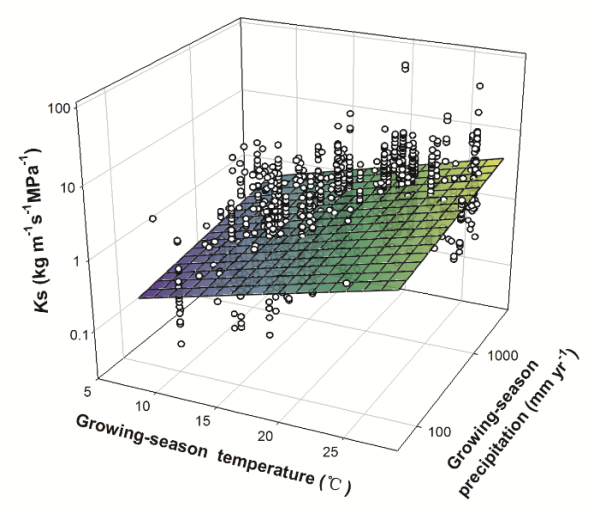

A recent research paper published in Global Change Biology describes the global variability in plant xylem hydraulic conductivity in relation to climatic variables, plant biomes and plant functional types.
Climate change will likely result in a redistribution of precipitation across the Earth’s surface, thus affecting the timing and amount of available water to plants and ecosystems. It is possible that shifts in temperature and rainfall patterns may lead to widespread forest decline in regions where droughts are predicted to increase in duration and severity. Quantifying physiological traits associated with water supply and drought survival (e.g., hydraulic conductivity and water potential at hydraulic dysfunction) has great potential for predicting shifts in community composition, species’ distribution, and ecosystem functioning.
Plant xylem hydraulic conductivity (KS), represents the water transport potential of the xylem tissue. It is expressed as the rate of water transport through a given area and length of sapwood across a given pressure gradient. Transporting water from soil to the canopy requires an intact water column in the xylem from roots to shoots. This processes is greatly facilitated by increasing KS, and as such, KS plays a critical role in achieving whole-plant water balance and is therefore critically linked with transpiration, photosynthesis, growth, and survival. The interaction between water availability and hydraulic capacity can also strongly influence the geographic distribution of plant species. However, our understanding remains limited about how KS varies across plant functional types and biomes, and which climatic factors drive variation in KS at the global scale.
A research group led by Professor YE Qing from South China Botanical Garden of Chinese Academy of Sciences compiled a KS dataset with 1186 species-at-site combinations (975 woody species representing 146 families, from 199 sites worldwide), and investigated how KS varied with climatic variables, plant functional types, and biomes. They found that growing-season temperature and precipitation drove global variation in KS independently. Both the mean and the variation in KS were highest in the warm and wet tropical regions, and lowest in cold and dry regions, such as tundra and desert biomes.
"Future warming and redistribution of seasonal precipitation may have a significant impact on species functional diversity, and is likely to be particularly important in regions becoming warmer or drier, such as high latitudes. Our study highlights an important role for KS in predicting shifts in community composition in the face of climate change." said Dr. HE Pengcheng, the first author of the paper.
For further reading, please refer to the paper entitled "Growing-season temperature and precipitation are independent drivers of global variation in xylem hydraulic conductivity" at https://onlinelibrary.wiley.com/doi/10.1111/gcb.14929.

Figure. Global variation in KS in relation to Tgs and Pgs.

